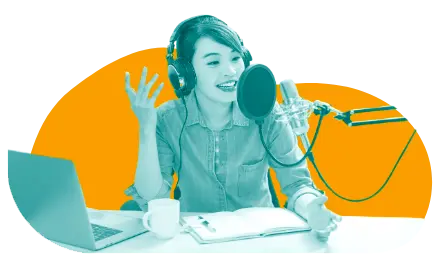
So many podcasts start out as a dream: “I’d love to … I wish I … Maybe I could … Wouldn’t it be fun? …” Well, now you’ve got a streamlined podcasting guide to start a podcast — TODAY!
These 10 steps will quickly help you learn how to start a podcast and keep podcasting.
STEP 1: Refine your podcast concept
STEP 2: Write down your podcast plan
STEP 3: Choose the best podcast hosting service
STEP 4: Setup your podcast on Libsyn
STEP 5: Choose the best podcast equipment for YOU
STEP 6: Record your podcast episode
STEP 7: Edit your podcast with podcast software
STEP 8: Publish your first podcast episode
Your area of expertise or interest is a great starting point for your new podcast concept.
A clear concept ensures that your central idea attracts an audience you love and inspires numerous topics to cover for the life of your show.
Ask Yourself: WHY do I want to start a podcast?
Sound Advice: Your “WHY” (and ultimately your podcast) should = your expertise + your passion, + your audience.
Broad Topic → Niche Topic
I love Yoga → Yoga For the Spine
Managing ADHD → ADHD Motherhood
The Addams Family Fancast → Wednesday Addams Fancast
Consider how many people are interested in your topic AND what percent of those are listening to podcasts. For more on niche content, read Niche Content with Kate Erickson.
Online artificial intelligence (AI) tools can help you with ideas for podcast episodes but use them only as starting points when you start a podcast. Always go back to your podcast why to help with topic ideas.
For example, we asked an AI tool for sub-topic ideas for a Wednesday Addams Fancast Podcast.
The results were the following:
Ask Yourself: Who is my ideal audience?
Deeper podcast listener questions:
Video Tip: Want the shorter video version? Check out these 6 STEPS You’ll Need to Start Your Podcast.
“Start with an outline or structure to build the system that you want — write out a set of steps, find tools and automation that can help you.” from Content Systems Before Sales with Kate Erickson.
These three questions will help you start thinking about what is possible.
Choose goals that provide you with some ROI — financially or emotionally. Podcasting takes time and commitment, and it takes at least a year to grow an audience.
Video Tip: Podcasting for under $100 — 2023. How to start a podcast with the most essential and affordable podcasting equipment.
Podcast host
Free → $$$
Starts at $5/mo on Libsyn
Podcast intro or outro music
Free → $$$
Free music options are included in all Libsyn plans
Podcast apps
Free → $$$
Libsyn offers FREE, continuously updated YouTube, Help Library, and Webinar content. Read this article Podcast Conferences Tips and Tricks, to find community conferences worth attending.
Conferences or education
Free → $$$
Libsyn offers FREE, continuously updated YouTube, Help Library, and Webinar content. Read this article Podcast Conferences Tips and Tricks, to find community conferences worth attending.
Podcast editing
Free → $$$
From the free tool Audacity to options like Hindenburg that integrate with Libsyn.
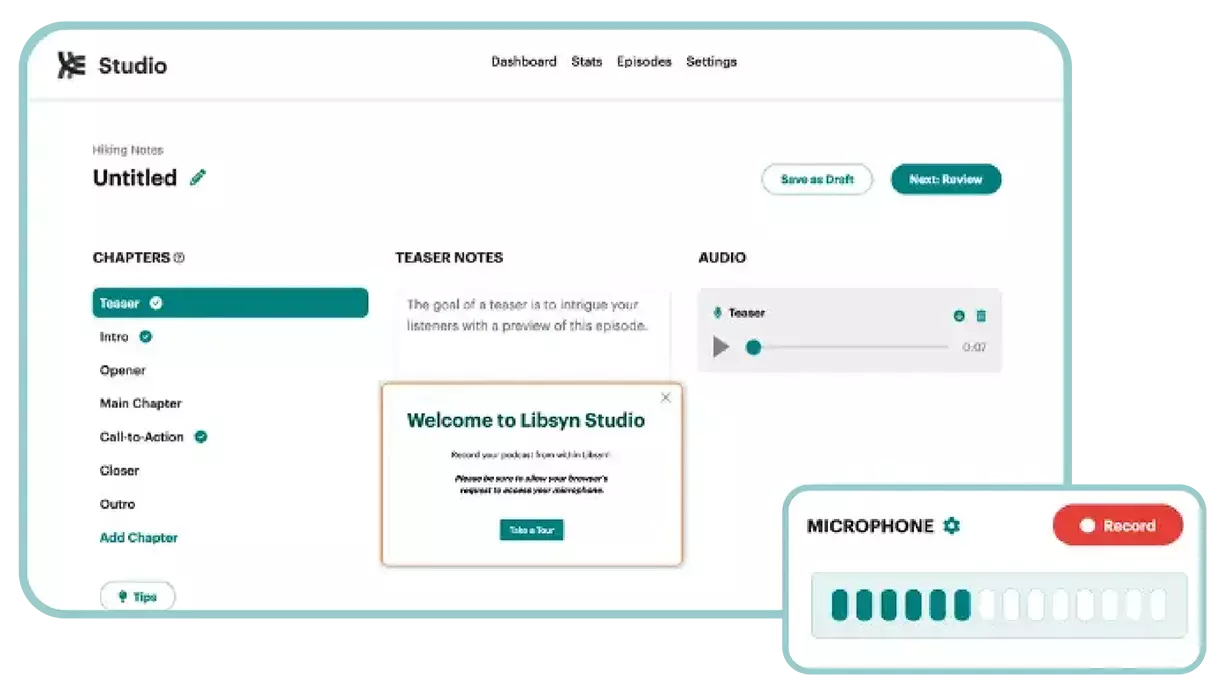
Libsyn provides a recording tool available with every Libsyn plan. It guides you through making a podcast and creating audio files ready to publish. It is the fastest and easiest way for Libsyn customers to start a podcast. With Libsyn, you can pack your episode recording expenses into one $5/mo podcast plan.
Podcasts come in many shapes and sizes, from 5-minute daily briefs to 3-hour monthly segments. Consider how your podcast budget might impact your format. Do you have the time and financial resources to create a daily video podcast with a co-host?
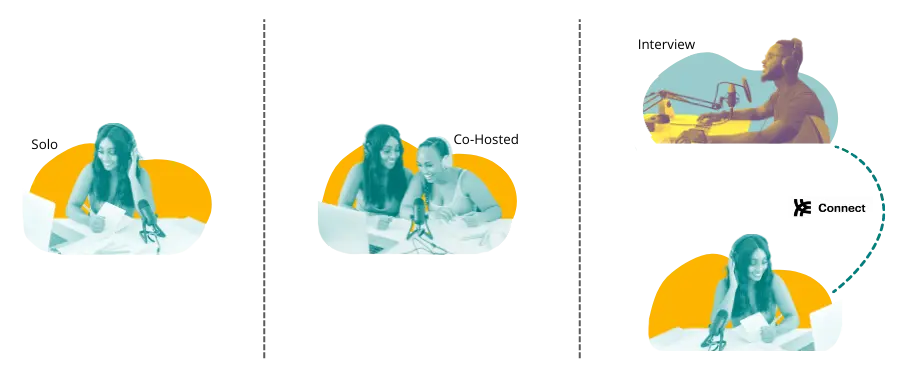
Libsyn podcaster Ginger Campbell from Brain Science was asked what podcasting wisdom she would share with new podcasters upon her induction into The 2022 Podcast Hall of Fame Ceremony.
Most Popular Podcast Formats:
How often you publish podcast, the length of your episode, and when you want to release your content will define many of the workflows you build to streamline your podcasting process.
For enterprise podcasting, Libsyn provides private podcasts, unlimited bandwidth, the ability to assign team member roles, a white-label podcast player, unlimited podcasts under one account, and support for podcast networks.
Look at the 24 Best Podcast Hosting Sites of 2023 for other podcast hosts and comparisons.
Below are some of the most common free learning materials:
Audio podcasts are more common for most new podcasters. Most of the podcasts available globally are audio only. With the expanded availability of video podcast recording tools like Squadcast and Riverside.fm, video podcast creation continues to grow.
VIDEO TIP:
Start a Video Podcast — Try Renting a Studio. This video will give you an inside look at how some audio podcasters avoid expensive equipment costs by renting spaces at boutique studios made for creators.
Ways Creators are Using Video Podcasts

We have an entire podcast help section on setting up and managing your podcast, but these three sub-steps require the most thought as you begin the process.
Your title or podcast name should be informed by best practices but also feature your identity as a creator and attract your ideal podcast listeners. You likely have a solid title idea if you’ve done your podcast research.
6 Title Best Practices Include
Keep it brief and intriguing → Stick to 20-26 characters with spaces.
Don’t keyword stuff → Include ONE key search word or phrase. Apple podcasts may reject stuffed titles.
Reveal a little personality → Will your podcast be funny, serious, or professional?
Avoid risky language → Like, is it 2,000 or Two Thousand? Is it Allowed or Aloud?
Avoid explicit language → This may limit what countries and apps will accept your podcast.
Avoid the word podcast → Why? Because everyone already knows what it is.
VIDEO TIP:
Can you update things later? Yes, you can! Elsie Escobar explains in the video Podcast Branding: Feel Free To Change!
The Internet
Podchaser.com
Apple Podcasts
Your favorite podcast app
Social platforms like Instagram, Facebook, Twitter handles, and hashtags
And finally, on the Copyright Public Records Portal.
“Beyond the Beskar: A Mandalorian Podcast”
“The Child’s Play: A Mandalorian Fan Podcast”
“Mando Missions: A Podcast Exploring The Mandalorian”
Do
Include some keywords that will help search engines discover you.
Hook your audience right from the start.
Share your description with a friend — what do they think?
Don’t
Include your show name again in the first few lines of your description.
State where people can listen or list your social media accounts.
Write it in a hurry and forget to spell-check — no typos, please.
Think of your podcast artwork as your podcast brand. It’s the first thing audiences see and often what compels them to listen. Apple Podcasts for Creators has a great list to keep in mind when designing podcast artwork. See below.
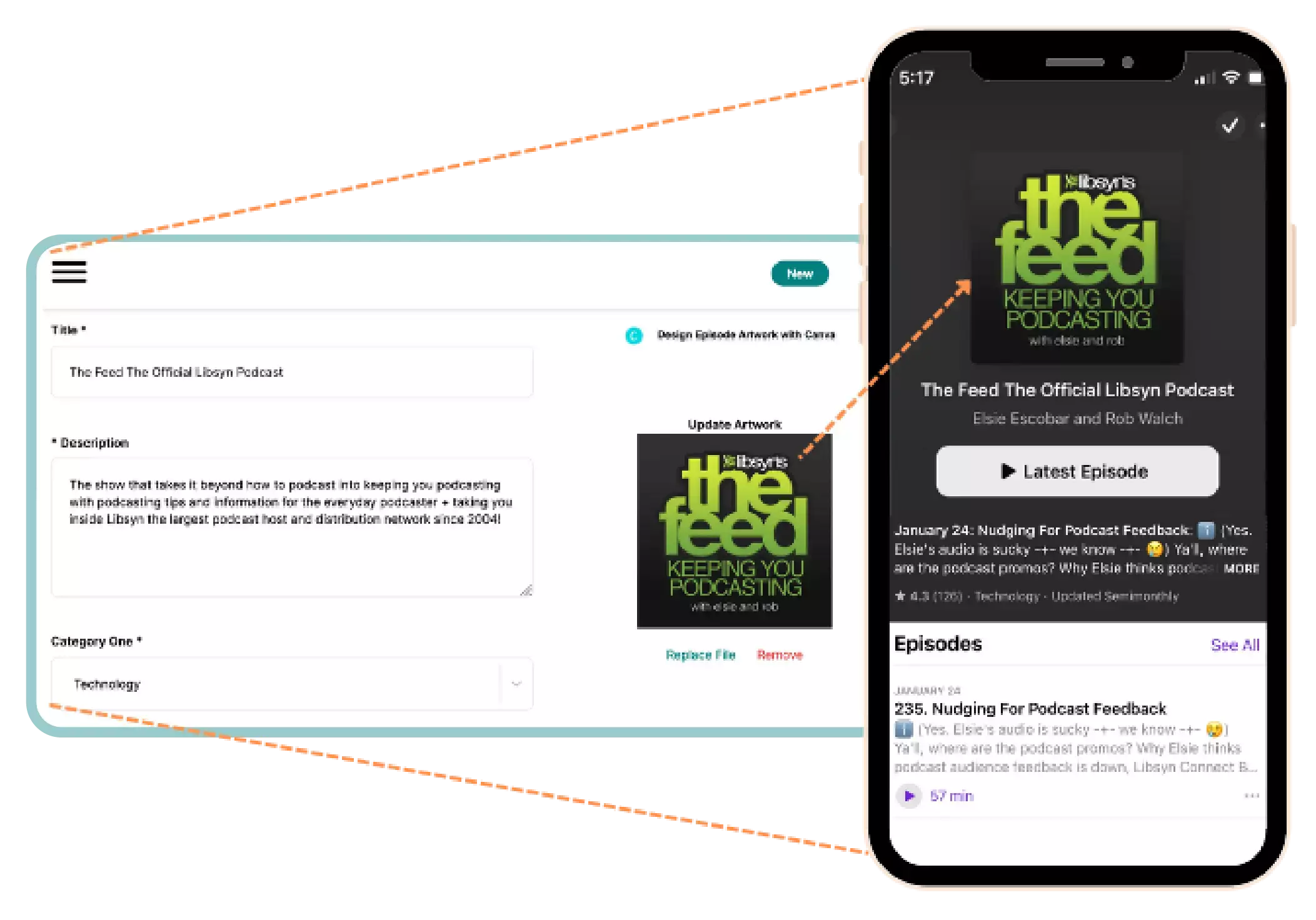
Artwork must be original and can’t contain any of the following:
Blurry, misaligned, mismatched, or pixelated images
Explicit language
Placeholder images
Apple or iTunes Store logos
The terms Apple Inc., Apple Podcasts, Apple Music, iTunes Store, or iTunes
Visual representation of Apple hardware
References to illegal drugs, profanity, or violence
Ads, sponsor logos, or marketing copy
Podcast cover art specs
1400 by 1400 px (minimum)
3000 by 3000 px (maximum)
Must be square
Under 500 kb
Use sRGB color space
JPG or PNG files only
Must measure 1920 by 1080 px
At least 72 dpi
Resources for creating podcast cover art
Canva Podcast Templates — Design with Canva is available in Libsyn
AI Artwork Generators like Midjourney — Proceed with caution; never generate a copyrighted image
Hire an artist from a place like Fiverr
VIDEO TIP: How to Think about Your Podcast Cover Art Design. Does yours stand out? Brian talks with two top designers, Doris Short and Prescott Perez-Fox, about how to approach cover art.
When it comes to podcast equipment, there are a ton of options. But in most cases, the basics you need for recording your new podcast include:
Podcast microphones & pop filters
Podcast headphones
Something to record into — desktop, tablet, laptop, or phone
Avoid these three microphone mishaps
VIDEO TIP: Mic Basics — How To Make Your Voice Sound Amazing! Michelle Levitt from @HeilSound & our own Elsie Escobar will give you all the terminology you need to understand the capabilities of your mic!
Ask Yourself: Take a look at this podcast studio tour video to see how 4 professional podcasters record in 4 very different locations. They’ll take you on a tour spotlighting everything from mics and mixers to audio editing, video, and location.
When it comes to podcast editing, there is one simple rule: more planning = less editing. If you’ve been spending too much time editing, it’s time to spend more time planning your podcast.
VIDEO TIP: In this LIVE Podcast Audio Rescue video, Mike Russell from Music Radio Collective and Brian Cottington from Libsyn show how to prevent audio problems, clean up audio, enhance your voice & more!
Audacity — With a slightly steeper learning curve than Garageband, Audacity is an open-source, easy-to-use, multi-track audio editor and recorder for Windows, macOS, GNU/Linux, and other operating systems.
Reaper — REAPER is a complete digital audio podcast production tool offering full multitrack audio and MIDI recording, editing, processing, mixing, and mastering capabilities.
Hindenburg Pro 2 — Hindenburg is an easy-to-learn, yet robust, field-tested audio editing platform designed to simplify and automate your spoken-word workflow.
Podcast publishing takes place within your podcasting platform. Your podcast service will take all the episode information you enter, combine it with your audio or video file, and publish it via your podcast RSS Feed.
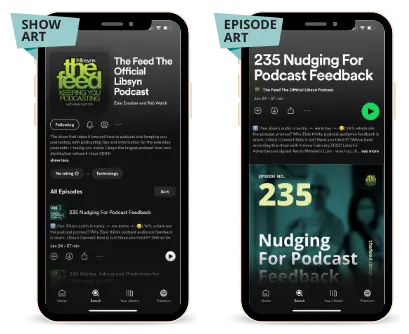
You learned about creating your podcast title, description, and podcast artwork above, but when it comes time to publish, each episode also has a unique title, description, and optional artwork. These are the elements your potential listeners will see in a podcast directory episode listing.
We provide a library of podcast publishing support and free start podcasting webinars starring Libsyn’s Head of Podcaster Education, Dave Jackson. Below are the basics for publishing, but you will find more optional fields in your podcast episode details form on Libsyn.
Employ best practices for your episode title
Try to keep your episode title character count between 20 and 26 and use one unique SEO term.
Do not duplicate your show title in the episode title.
Do not list your episode number in the Apple title.
Do the same for your podcast episode description
Super-charged copy — Start with 2 to 5 lines describing the episode content; make it compelling.
Podcast CTAs — Any links to show-related requests, i.e. newsletter signup.
Sponsor CTAs — Links to sponsor landing pages or products.
Links to access — List of your links on the most popular apps.
Source/reference links — Important when referencing data from a study or another podcaster.
Topic timestamps — Help listeners control their listening experience, especially if your content is long and covers many topics.
VIDEO TIP:
In this video, we explain Libsyn’s text snippets that allow you to store the most frequently used elements of your description and use them repeatedly.
The requirements for episode artwork are the same as for your podcast cover art. Libsyn provides integration with Canva, so you can easily use one of their templates to create your own.
As mentioned above, all Libsyn plans come with a website and podcast players. They are important tools for growing a successful podcast.
Podcast websites typically include:
Your podcast player with your current episode
Where to subscribe to your podcast (directories and apps where it lives)
Show description, about the show and hosts
Links to your social accounts or featured content
Links to any additional offerings or courses or ways you make money podcasting.
Upcoming events, live shows, or a CTA for audience feedback.
If you feel you need more robust website support, consider a website host. Pair offers templates designed especially for podcasting. It takes just a minute to create a branded website with your RSS feed. And, Pair Networks offers a free month’s trial.
Libsyn is one of the first podcast hosting services to support Apple Podcasts Delegated Delivery. This means that Libsyn podcasters can simply submit their podcast to Apple Podcasts from the Libsyn platform.
Note that once you are an Apple Podcast, you can also take app-specific promotional steps. See this blog detailing How to Get Featured on Apple Podcasts.
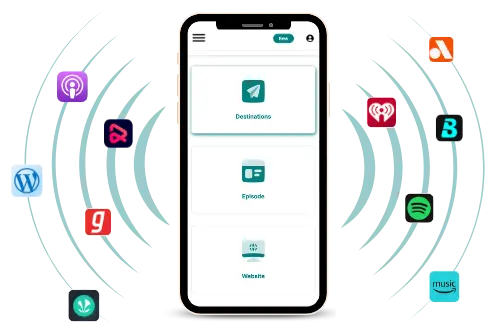
Quick Links to Podcaster Favorites
Set up your Libsyn podcast to automatically publish to the most popular podcast apps and directories below. Follow the instructions in the Connect Your Show to Publish Episodes to a Destination Feed help article to ensure your podcast is available everywhere.
iHeartRadio
Audacy
Deezer
Amazon Music/Audible
Gaana
Player FM
Samsung
JioSaavn
Boomplay
Resso
Customize Your Spotify Feed
Being on every possible app is an important way to reach new audiences. Note that some international destinations will not accept explicit content.
While the industry’s common metric for podcast audience growth is downloads, there is a lot more nuance to growth and success tied to your podcast goals AND your podcast WHY. If you are interested in podcast monetization, you will want to focus on downloads.
VIDEO TIP:
Don’t Plateau! Keep Increasing Your Podcast Audience. Panelists Chris Krimitsos, CEO of Podfest Expo and Hala Taha, creator, and CEO of YAP Media join Bryan Green to highlight strategies they have used to grow new podcasts with no downloads, and break free from the “download plateau” with larger, more established podcasts.
VIDEO TIP:
Learn the best practices to market your podcast through social media — and common practices to avoid.
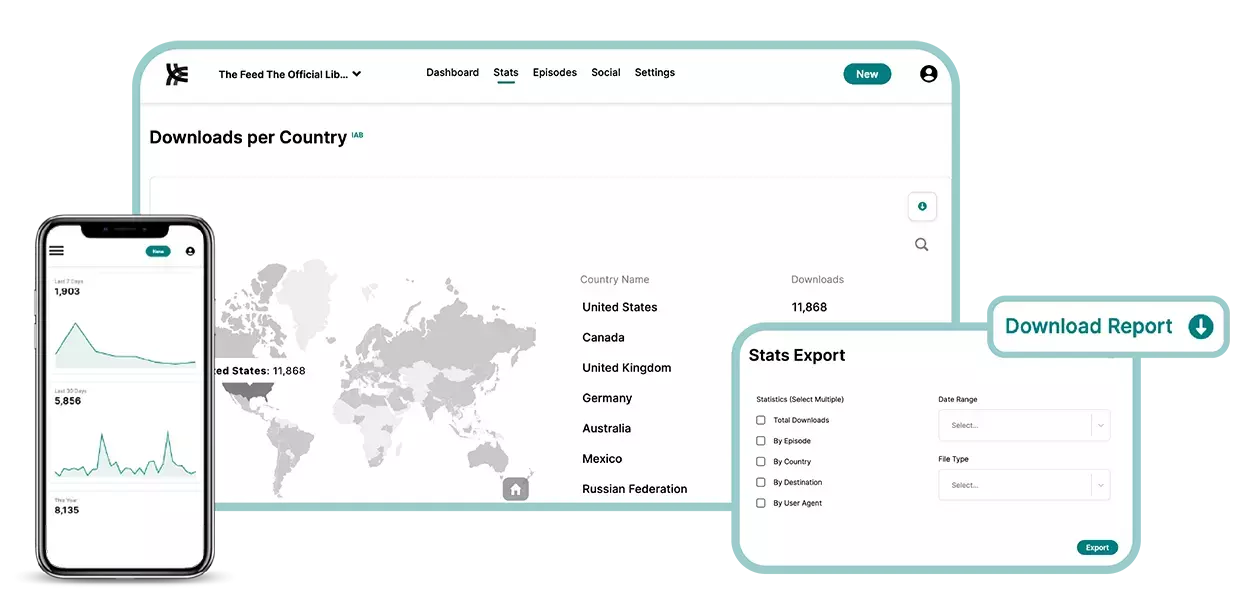
Libsyn Advanced Stats Include:
User-Agent — The channels used to listen to your podcast; can include browser & app data.
Geographic — A heat map of the countries where your podcast is most popular by episode.
Destination — Breakouts of all destinations created in your Libsyn account.
Social Media Marketing — Performance reports from connected social media accounts.
Day, Week, and Month — Daily, weekly, or monthly stats for quick trend analysis.
Date Range Selector — Specific historic date ranges and downloads across all reporting.
Episode Stats & Breakdowns — Details of exactly what content is most popular.
Downloadable Stats Reporting — Exportable stats for analysis or sharing.
Advanced Stats Codes — Track your podcast player performance. Learn more here..
Podcast monetization typically falls into three categories: podcast subscriptions, podcast advertising, and the sale of podcaster services or products. Note that very few podcasters are able to monetize when just starting up, even if it’s part of their podcasting goals.
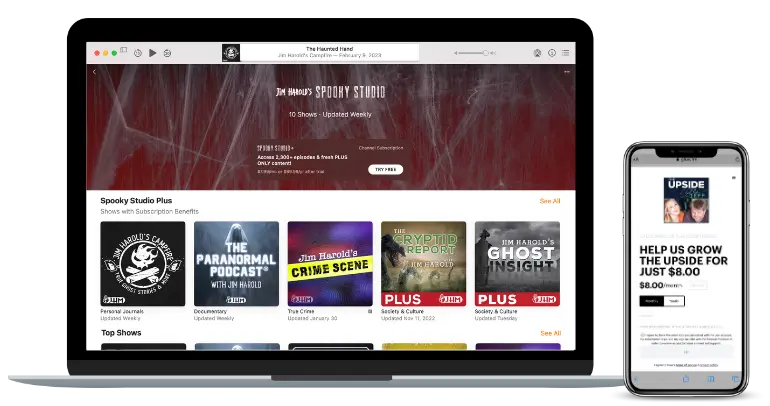
Libsyn is among the first podcast platforms to integrate with Apple Podcasts Subscriptions, Apple Podcasts Subscriptions is designed for creators to offer audiences monthly or annual subscription plans. Plans can include access to exclusive content, early access, ad-free listening, etc. A subscription is also a great place to make your services and products available. You set the price and plan that work for you and your audience.
Ready to launch a subscription? Start here: How to Set Up Apple Podcasts Subscriptions.
Libsyn’s Glow also allows you to offer premium bonus content, products, and services to loyal listeners with no minimum download requirement. Glow runs your subscription; you concentrate on creating content that loyal fans WANT to pay for.
VIDEO TIP: Libsyn’s Elsie Escobar shares easy ways to create bonus material by repurposing content you already have in your workflow.
If you’re considering podcast advertising, you should be in a place where you have built up an audience and stepped up your promotional pace. Libsyn Ads is an advertising network that allows podcasters to list their shows for advertisers to browse and select.
Read more about making podcast advertising partnerships work with Erica Mandy who knows the podcast advertising industry well and makes a living podcasting!
Automatic Ads allow you to monetize your Libsyn podcast by dynamically inserting ads within your podcast. Unlike live reads, automatic ads are just that — automatic! Nothing for you to record, and because they are not baked into your episodes, you have the ability to monetize your back catalog.
Campaigns can be run for one brand, completed, and a new campaign can start without any action needed from the podcaster! Different types of campaigns pay differently, and average podcast advertising rates are available on the Libsyn blog.
See if your podcast qualifies for the Libsyn Auto-Ads program now!
VIDEO TIP: Check out this video that compares the pros and cons of dynamic and baked-in ads.
You will find that most podcasters are helpful, collaborative, and excited to share what they’ve done and how they did it. Following podcast hosts like Libsyn on Instagram @libsyn, Twitter @libsyn, YouTube, Crowdcast, Facebook, and LinkedIn will connect you to communities and offer a constant source of learning materials and interaction. Enjoy:
Great resources for additional research and free podcast education
Popular industry publications: Podcasting Business Journal, Inside Podcasting, Podnews
Niche or community facebook groups: Podcast Movement and She Podcasts
Industry Conferences: Podcast Movement, Podfest, Afros and Audio & She Podcasts Live
Podcast advertising events: Xfronts and IAB Newfronts